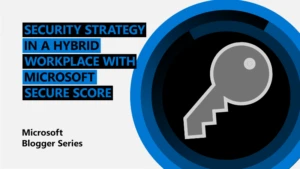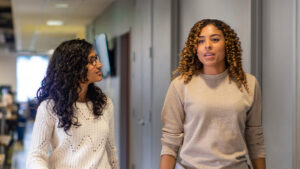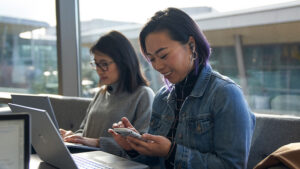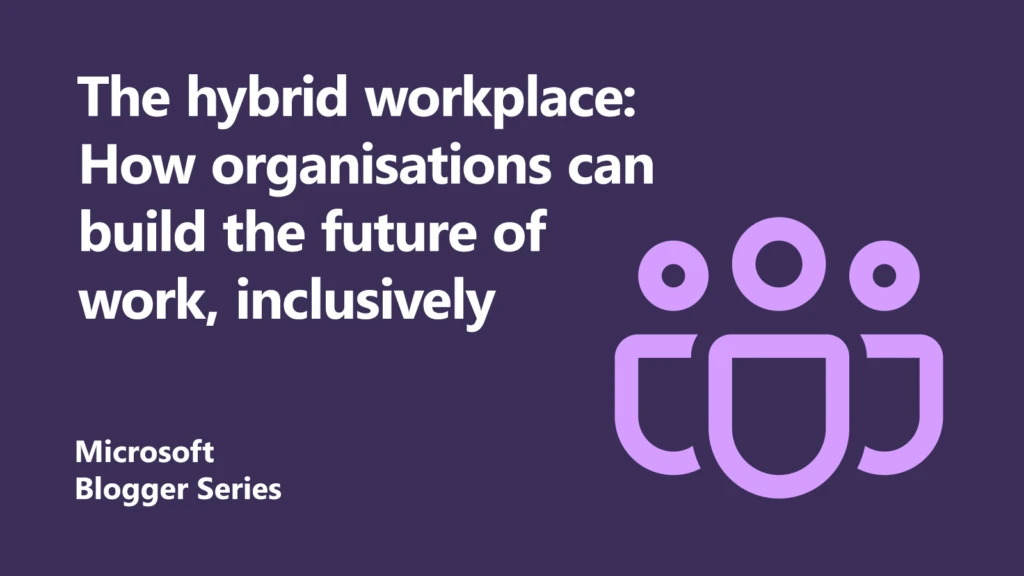
The hybrid workplace: How organisations can build the future of work, inclusively
It’s been a challenging year. All of us have felt the effects in one way or another. It has disrupted how we live and work. As a result, there has been a lot of talk about the future of work. Working practices which were able to switch to digital have done so at pace. This has allowed sectors of the economy to continue and, in some cases, thrive. Shifts in business processes previously took years, but now they are happening in weeks and months. Yet, this shift introduced a new set of challenges. Currently, remote working fatigue is a common concern amongst business leaders and they are worried about their employee’s wellbeing.
It will take time for the new hybrid workplace to emerge. At Microsoft, we continue to take a people and design-centred approach to hybrid working. To help leaders build an inclusive hybrid workplace, we focus on the perspectives of four employees. We look at their wants and needs, their current situation, and what their desired normal future of work looks like.
- Balancing work and home: Sarah’s story
- Building inclusivity and accessibility: Raj’s story
- Staying connected while apart: Mike’s story
- Starting a new career: Veronica’s story
Balancing work and home: Sarah’s story
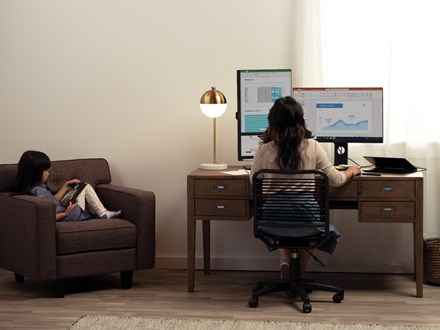
Sarah is an architect in the construction industry. She is a professional, a wife and mother, and the primary carer of two daughters. As a result, she finds balancing work and home demands a constant struggle.
Pre-remote working
Before our shift to remote working, Sarah often struggled to achieve a healthy balance between her professional and family life. Long days could involve up to four hours in the car. There were design meetings, planning meetings and site visits to attend, often at multiple locations. Sometimes she would get home late. That meant she would miss the opportunity to catch up with her family. This made her feel disconnected and like she was failing at home.
Remote working
Not having to travel has been a revelation for Sarah. Home schooling is difficult to manage. However, the extra 10+ hours a week Sarah gains by not travelling means she can spend more time with her family. Also, she has more time to keep her clients happy and projects on track.
As everyone got used to remote working, there were some initial misunderstandings and mistakes. However, everyone quickly adapted.
Whereas she would do this informally in the office, smaller scheduled meetings and more regular diarised check-ins helped Sarah stay on top of her work. Unfortunately, Sarah’s broadband was disconnected for two days and that had a big impact on everyone – work, school and entertainment were all affected. The family have since changed provider and upgraded their package to make the connection more reliable.
Sarah’s desired normal in the future of work
A year on, Sarah does occasionally miss the buzz and connection of the office. It’s made her recognise the importance of face-to-face connection. But through remote working, she has found a work life balance that was unobtainable before. Her firm are discussing their return to workplace strategy. Sarah hopes she can continue to be empowered to meet her client, project and family needs in a way that works well for her.
Building inclusivity and accessibility: Raj’s story
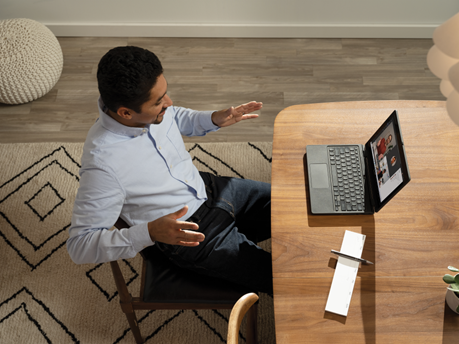
Raj is a partner at a management consulting firm. He has a late acquired disability. This has impacted the way he delivers his work.
Pre-remote working
Raj was happy with his career progression. However, his late acquired disabilities meant he faced a lot of challenges delivering his work. Unable to use public transport or stay overnight in new cities without elaborate carer arrangements, Raj had a lot of restrictions in terms of the customers he could serve.
For the customers he could serve, Raj had to put in a lot of effort to manage travel arrangements. Also, he had to deal with all the unknowns that come with new locations. He remembers several occasions when he had to wake up at 4am to be part of morning face to face meetings. To do that, his wife needs to assist him, as the carer can’t attend that early. At times, he would travel over three hours for a two-hour face to face customer meeting and make the same arduous journey back. There were several incidents where he came across meeting rooms that were not accessible. In all this, he never felt that he was doing anything extraordinary because that was the only way he could get work done – that was his normal.
Remote working
2020 changed Raj’s whole perspective about workplace productivity. It also changed his opinion on the meaning of equitable environments for people with disabilities. The rapid pace of digital transformation enabled an unprecedented level of digital inclusion in our society.
Overnight, everything became more accessible. All those customers that Raj couldn’t travel to are now in his reach. With all the time saved he has become much more productive. His wellbeing has also improved, as he no longer worries about accessibility when travelling to meet clients. This year, Raj is handling three times the workload compared to last year. He still has time to publish new intellectual property, mentor colleagues and students and advise start-ups. He also has more time to spend with his family.
Raj’s desired normal in the future of work
What’s been brought home to Raj is the power of technology. It’s a major catalyst to enable the full participation of people with disabilities in the digital economy. Raj realises he has a voice and role in taking this opportunity forward and removing the barriers to a truly inclusive digital future of work.
Staying connected while apart: Mike’s story
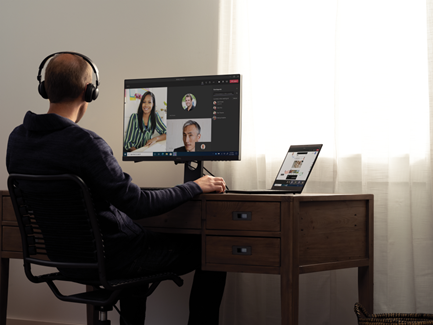
Mike is an assistant buyer for a large online retailer. He is single and has no dependents. This job is the first time he has lived away from home.
Pre-remote working
Mike has been an assistant buyer for two years. After graduating from a university – which was close to his hometown – he took the brave step of leaving his friends and family. He moved 200 miles for his job. His working life was spent either in the office, on the road, or travelling across Asia with colleagues looking for the next great product.
Mike’s social life also circulated around work. He caught up with colleagues over a coffee, is a member of the company sports team and enjoyed team socials. While Mike lived alone, most of his time was spent with others either at work or in social situations.
Remote working
In 2020, Mike shifted to working from home. Due to both his work and personal technology, he felt he could be just as productive or even more productive than when he was travelling. In the beginning, he was enjoying not having to travel. He was able to do things that he did not have time for before. After a few weeks however, he started to realise how much he relied on work for social interaction and began to feel isolated. After four months, the social isolation took its toll. Mike decided to move back home.
Mike’s desired normal in the future of work
Mike can see that there are plans to return to the office. Soon, things will start to go back to some kind of normality. He is looking forward to getting back into the office. He’s also starting to travel again as he has missed those elements of the role. However, Mike has proven that he can be productive from anywhere. While remote working has made some things complex, he believes hybrid working is the way to go.
Mike has been speaking to his manager about the possibility of a home working contract. He doesn’t want to permanently relocate again. In addition, he believes the company would get more value from this arrangement. Mike has decided that if his employer forces him to move closer to the office then he will have to look for a new position. The market for his skills appears buoyant.
Starting a new career: Veronica’s story
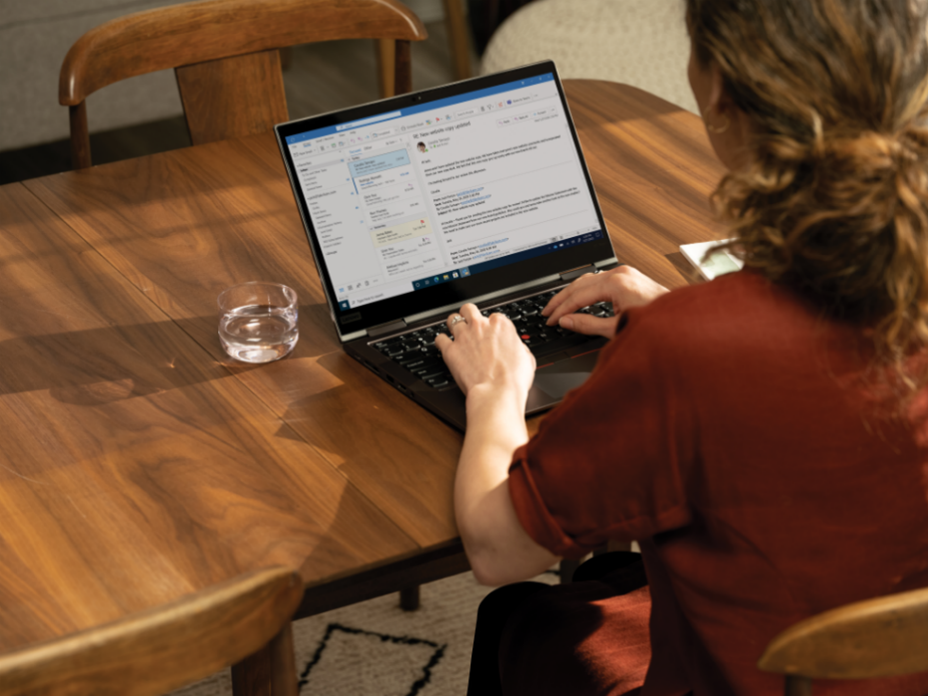
Veronica is an intern at a large tech company. She is excited to pick up experiences and skills which would help her secure her first job once she has obtained her degree.
Pre-remote working
Veronica’s excitement to start her work placement turned to dread in 2020. She had moved to a new city to be near her workplace. She was looking forward to onboarding into her role, meeting her colleagues and getting settled in. Yet government restrictions meant that all offices closed.
Remote working
On-boarding into her new role was difficult. There was great supporting infrastructure in the form of digital platforms, training, and tools. However, Veronica felt she would have benefited from more 1:1 guidance and mentoring, especially whilst she was settling in. Instead, she found that her days were full of meetings. Whilst everyone was generally helpful, it could at times be overwhelming. She was sometimes unsure of whether she was prioritising the right tasks. This made her feel anxious.
Veronica’s desired normal in the future of work
Veronica hopes the world will learn from the last year. Digital tools are a great benefit and enable ‘work anywhere’ flexibility. However, she has found as someone early in career, that sometimes working in the same space as her team can have benefits too, such as building a greater sense of camaraderie and connection. She feels that if she had had more help in her on-boarding it would have helped to build her confidence faster and to accomplish more during her work placement.
Designing the hybrid workspace in the future of work
The future of work needs to be intentionally focused on three things:
- The work we will do.
- How we will work.
- The value the work creates.
The workplace shouldn’t be focussed on location. Nor should it be driven by the personal preferences and habits of the influential few. With just these four stories, we can see how different individual preferences are. But what connects them? Digital technology.
By taking a people-oriented approach we can design the future of work. We’ll build strategies that work for everyone. Investing in digital tools opens the door to the opportunity but investing in a digital culture realises it. Leaders have a pivotal role to play in enabling the future of work. They can empower others to do their jobs in a way that works for them, whilst also satisfying the needs and wants of the customers they serve.
Find out more
Microsoft Viva: The employee experience platform
Create an agile and innovative hybrid workplace
3 steps to build a successful hybrid working framework
About the authors
 Prajakt is a management consulting professional with more than 17 years of experience in serving large global clients. He specialises in business consulting and advisory services; driving digital modernisation for customers.
Prajakt is a management consulting professional with more than 17 years of experience in serving large global clients. He specialises in business consulting and advisory services; driving digital modernisation for customers.Currently, Prajakt is an Industry Advisory Lead for the Local and Regional Government sector in Microsoft Services.
Previously, Prajakt was heading the Europe consulting services for Tech Mahindra serving large global customers like British Telecom, Vodafone, Telefonica etc., in addition to leading implementations for various smart city initiatives across the UK.
 Terry Room is currently a Managing Architect for Microsoft Consulting Services in the UK. With over 20 years of technology industry experience, he leads a cross disciplinary team of consulting architects and digital advisors, with a focus on driving large scale business and technology transformation with strategic enterprise customers through the design of compelling business cases, resilient technology architectures, and transformation programmes which deliver sustainable business value.
Terry Room is currently a Managing Architect for Microsoft Consulting Services in the UK. With over 20 years of technology industry experience, he leads a cross disciplinary team of consulting architects and digital advisors, with a focus on driving large scale business and technology transformation with strategic enterprise customers through the design of compelling business cases, resilient technology architectures, and transformation programmes which deliver sustainable business value.

